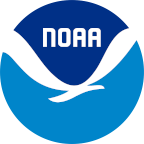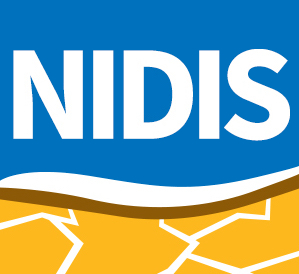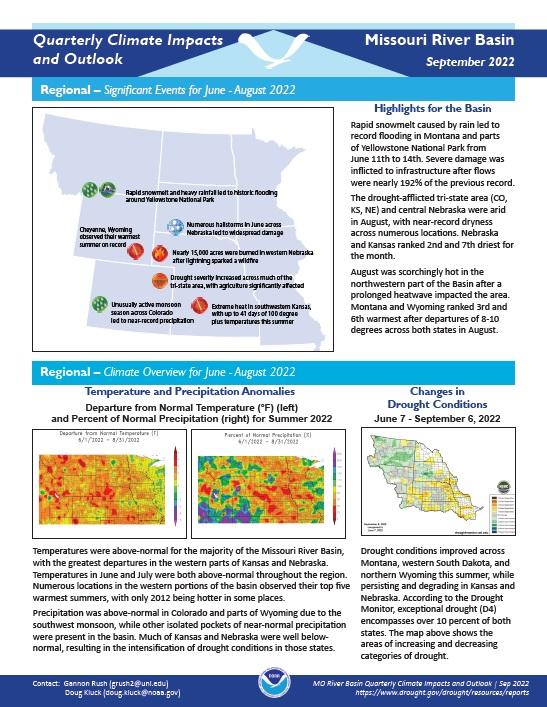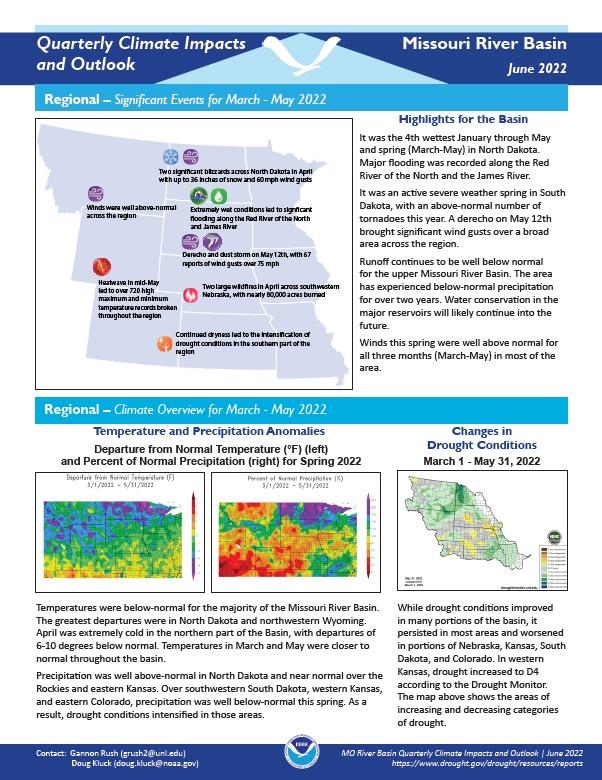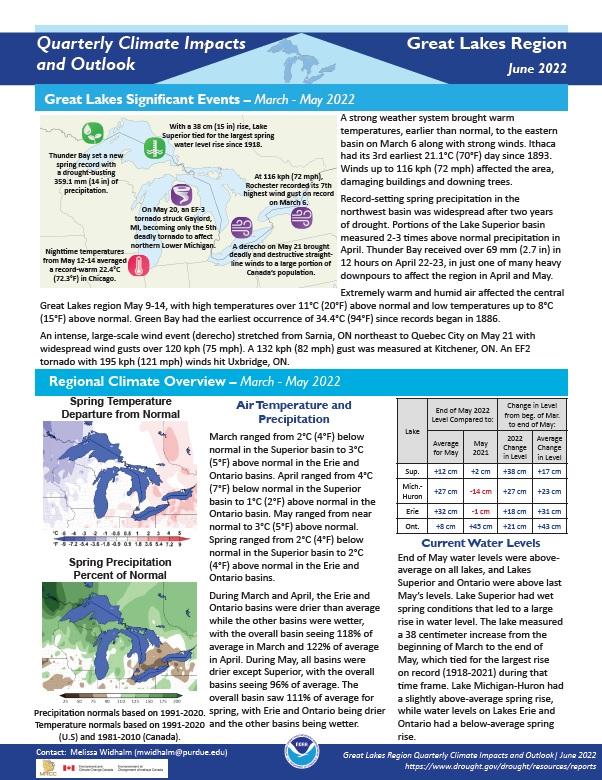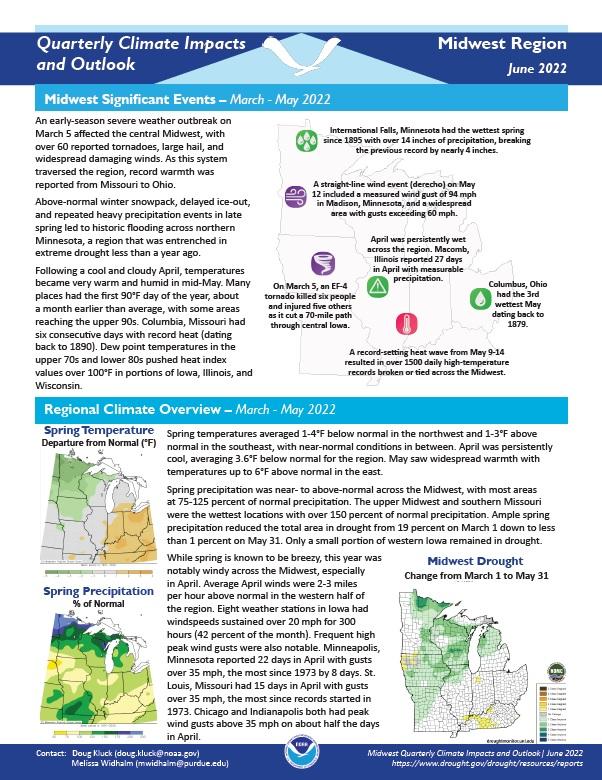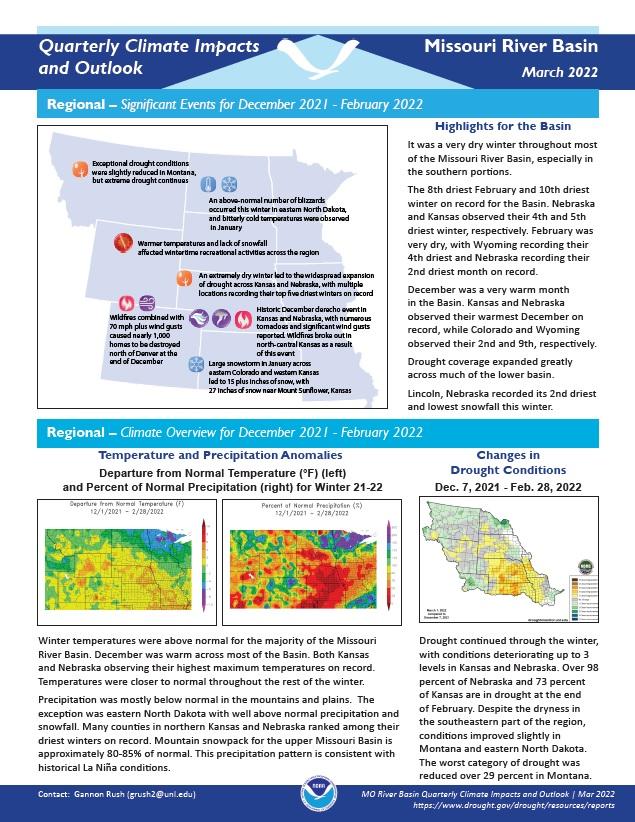Quarterly Climate Impacts and Outlook for the Missouri River Basin for June–August 2022. Dated September 2022.
Temperatures were above normal for the majority of the Missouri River Basin, with the greatest departures in the western parts of Kansas and Nebraska. Precipitation was above normal in Colorado and parts of Wyoming due to the Southwest Monsoon, while other isolated pockets of near-normal precipitation were present in the basin. Much of Kansas and Nebraska were well below normal, resulting in the intensification of drought conditions in those states.
Quarterly Climate Impacts and Outlook for the Great Lakes Region for June–August 2022. Dated September 2022.
June, July, and summer were within 1°C (2°F) of normal for most of the basins, with a few U.S. locations that were warmer. The overall basin saw 90% of average precipitation for summer, and all basins were drier than normal.
Quarterly Climate Impacts and Outlook for the Midwest Region for June–August 2022. Dated September 2022.
Temperatures were 1–4°F above normal in the west and south during the summer, with the central portion of the region near normal. Summer precipitation was near normal to as much as 175% of normal east of the Mississippi River and as low as 50% of normal to the west.
Quarterly Climate Impacts and Outlook for the Missouri River Basin for March–May 2022. Dated June 2022.
Temperatures were below normal for the majority of the Missouri River Basin. The greatest departures were in North Dakota and northwestern Wyoming. Precipitation was well above normal in North Dakota and near normal over the Rockies and eastern Kansas. Over southwestern South Dakota, western Kansas, and eastern Colorado, precipitation was well below normal this spring.
Quarterly Climate Impacts and Outlook for the Great Lakes Region for March–May 2022. Dated June 2022.
Spring ranged from 2°C (4°F) below normal in the Superior basin to 2°C (4°F) above normal in the Erie and Ontario basins. The overall basin saw 111% of average precipitation for spring, with Erie and Ontario being drier and the other basins being wetter.
Quarterly Climate Impacts and Outlook for the Midwest Region for March–May 2022. Dated June 2022.
Spring precipitation was near- to above-normal across the Midwest, with most areas at 75%–125% of normal precipitation. The upper Midwest and southern Missouri were the wettest locations with over 150% of normal precipitation. Spring temperatures averaged 1–4°F below normal in the northwest and 1–3°F above normal in the southeast, with near-normal conditions in between.
Quarterly Climate Impacts and Outlook for the Missouri River Basin for December 2021–February 2022. Dated March 2022.
Winter temperatures were above normal for the majority of the Missouri River Basin. Precipitation was mostly below normal in the mountains and plains. The exception was eastern North Dakota with well-above-normal precipitation and snowfall. Many counties in northern Kansas and Nebraska ranked among their driest winters on record.
Quarterly Climate Impacts and Outlook for the Great Lakes Region for December 2021 - February 2022. Dated March 2022.
Winter temperatures ranged from 4°C (11°F) colder-than-normal to 1°C (2°F) warmer-than-normal. Overall, winter precipitation was 82% of average for the basin.
Quarterly Climate Impacts and Outlook for the Midwest Region for December 2021 - February 2022. Dated March 2022.
The Midwest region has endured many droughts that have led to billion dollar losses, with examples over the last 30 years including 1980s, 2005, and 2012. Neither the onset or demise of the 2005 and 2012 droughts over the Midwest were forecast. The goal of this NIDIS-funded research study led by NOAA’s Physical Sciences Laboratory is to build a predictive understanding of drought and to quantify the risks of droughts with certain characteristics in the Midwest region.
